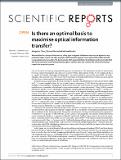Files in this item
Is there an optimal basis to maximise optical information transfer?
Item metadata
| dc.contributor.author | Chen, Mingzhou | |
| dc.contributor.author | Dholakia, Kishan | |
| dc.contributor.author | Mazilu, Michael | |
| dc.date.accessioned | 2016-03-16T13:30:04Z | |
| dc.date.available | 2016-03-16T13:30:04Z | |
| dc.date.issued | 2016-03-15 | |
| dc.identifier | 241163684 | |
| dc.identifier | a6a06152-ef41-44de-bcc4-f558fbec8368 | |
| dc.identifier | 84962538041 | |
| dc.identifier | 000372029800001 | |
| dc.identifier.citation | Chen , M , Dholakia , K & Mazilu , M 2016 , ' Is there an optimal basis to maximise optical information transfer? ' , Scientific Reports , vol. 6 , 22821 . https://doi.org/10.1038/srep22821 | en |
| dc.identifier.issn | 2045-2322 | |
| dc.identifier.other | ORCID: /0000-0002-6190-5167/work/47136390 | |
| dc.identifier.uri | https://hdl.handle.net/10023/8425 | |
| dc.description.abstract | We establish the concept of the density of the optical degrees of freedom that may be applied to any photonics based system. As a key example of this versatile approach we explore information transfer using optical communication. We demonstrate both experimentally, theoretically and numerically that the use of a basis set with fields containing optical vortices does not increase the telecommunication capacity of an optical system. | |
| dc.format.extent | 8 | |
| dc.format.extent | 1067643 | |
| dc.language.iso | eng | |
| dc.relation.ispartof | Scientific Reports | en |
| dc.subject | QB Astronomy | en |
| dc.subject | QC Physics | en |
| dc.subject | DAS | en |
| dc.subject | BDC | en |
| dc.subject.lcc | QB | en |
| dc.subject.lcc | QC | en |
| dc.title | Is there an optimal basis to maximise optical information transfer? | en |
| dc.type | Journal article | en |
| dc.contributor.sponsor | EPSRC | en |
| dc.contributor.sponsor | EPSRC | en |
| dc.contributor.institution | University of St Andrews. School of Physics and Astronomy | en |
| dc.contributor.institution | University of St Andrews. Biomedical Sciences Research Complex | en |
| dc.identifier.doi | 10.1038/srep22821 | |
| dc.description.status | Peer reviewed | en |
| dc.identifier.grantnumber | EP/M000869/1 | en |
| dc.identifier.grantnumber | EP/J01771X/1 | en |
This item appears in the following Collection(s)
Items in the St Andrews Research Repository are protected by copyright, with all rights reserved, unless otherwise indicated.

